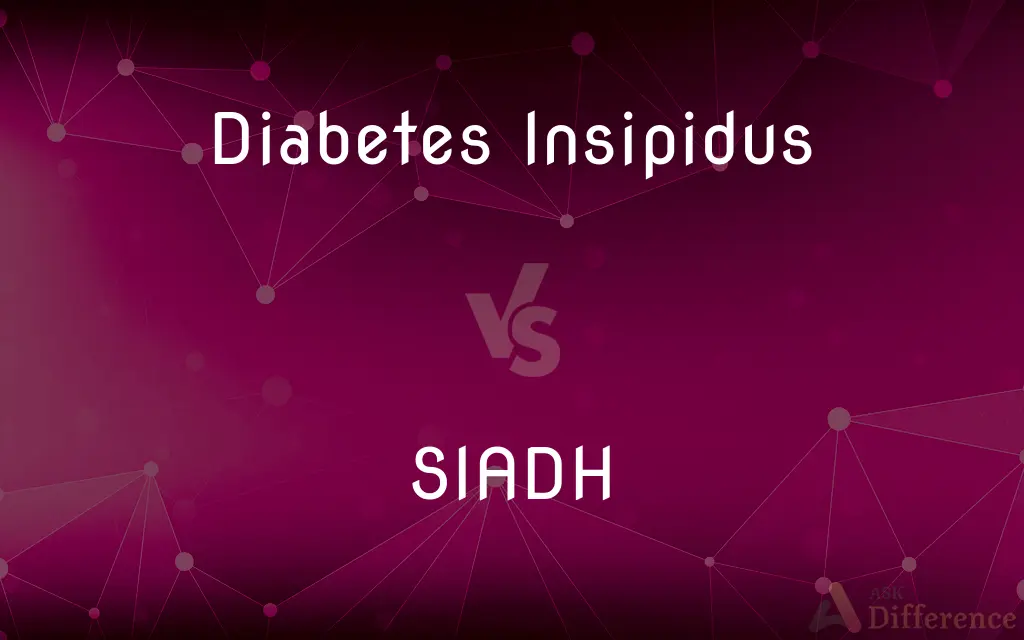Diabetes Insipidus vs. SIADH — What's the Difference?
By Tayyaba Rehman — Published on January 24, 2024
Diabetes Insipidus is a condition characterized by excessive urination and thirst due to inadequate antidiuretic hormone (ADH) effects, while SIADH (Syndrome of Inappropriate Antidiuretic Hormone) involves excessive ADH leading to water retention.

Difference Between Diabetes Insipidus and SIADH
Table of Contents
ADVERTISEMENT
Key Differences
Underlying Mechanism: Diabetes Insipidus is caused by a deficiency of ADH or the kidney's response to ADH, leading to excessive water loss. In contrast, SIADH is characterized by excessive secretion or action of ADH, resulting in water retention.
Symptoms: Patients with Diabetes Insipidus experience intense thirst and large volumes of dilute urine. SIADH patients, however, often exhibit symptoms related to low sodium levels, such as confusion or seizures, due to excess water diluting blood sodium.
Diagnosis: Diagnosis of Diabetes Insipidus involves water deprivation tests and measuring ADH levels, while SIADH diagnosis typically includes assessing blood and urine osmolality and sodium levels.
Treatment: Treatment of Diabetes Insipidus may include ADH replacement therapy. SIADH treatment focuses on restricting fluid intake and addressing the underlying cause of the hormone imbalance.
Associated Conditions: Diabetes Insipidus can be associated with damage to the hypothalamus or pituitary gland, while SIADH is often related to conditions like lung disease, brain injury, or certain medications.
ADVERTISEMENT
Comparison Chart
Hormonal Issue
ADH deficiency or insensitivity
Excessive ADH secretion or action
Primary Symptoms
Excessive urination, intense thirst
Water retention, low blood sodium
Diagnostic Tests
Water deprivation test, ADH measurement
Blood and urine osmolality, sodium levels
Treatment Approach
ADH replacement, managing fluid intake
Fluid restriction, treat underlying cause
Common Associations
Hypothalamic or pituitary damage
Lung disease, brain injury, medications
Compare with Definitions
Diabetes Insipidus
A disorder causing excessive urination and thirst.
He was diagnosed with Diabetes Insipidus after experiencing severe dehydration.
SIADH
Low sodium in the blood, a common sign of SIADH.
Euvolemic hyponatremia in SIADH requires careful medical management.
Diabetes Insipidus
The signs of Diabetes Insipidus, like frequent urination.
His primary Diabetes Insipidus symptoms were excessive thirst and urination.
SIADH
Medical approach to managing SIADH.
SIADH treatment often involves fluid restriction and salt tablets.
Diabetes Insipidus
Diabetes Insipidus due to a lack of ADH production.
Central Diabetes Insipidus is often treated with synthetic ADH.
SIADH
A condition of excessive ADH leading to fluid retention.
SIADH can lead to dangerously low sodium levels.
Diabetes Insipidus
A type where kidneys don't respond to ADH.
Nephrogenic Diabetes Insipidus can be challenging to manage.
SIADH
Symptoms associated with SIADH, such as confusion or nausea.
The patient's SIADH symptoms included severe headaches and disorientation.
Diabetes Insipidus
Medical management of Diabetes Insipidus.
Diabetes Insipidus treatment often involves balancing fluid intake.
SIADH
The underlying factors leading to SIADH.
Lung cancer is sometimes a cause of SIADH.
Common Curiosities
What leads to SIADH?
SIADH is caused by excessive secretion or action of ADH.
How is Diabetes Insipidus diagnosed?
Through water deprivation tests and measuring ADH levels.
What are the main symptoms of Diabetes Insipidus?
Excessive thirst and urination are key symptoms.
What symptoms are associated with SIADH?
Symptoms include confusion, nausea, and seizures, due to low blood sodium.
Is Diabetes Insipidus common?
It's a rare condition compared to diabetes mellitus.
What causes Diabetes Insipidus?
It's caused by a deficiency of ADH or the kidney's insensitivity to ADH.
How is Diabetes Insipidus treated?
Treatment may involve ADH replacement therapy and managing fluid intake.
What is Central Diabetes Insipidus?
It's a type of Diabetes Insipidus caused by insufficient production of ADH.
What are the diagnostic criteria for SIADH?
Diagnosis includes assessing blood and urine osmolality and sodium levels.
What is the treatment for SIADH?
It involves fluid restriction and addressing the underlying cause.
Can Diabetes Insipidus lead to dehydration?
Yes, due to excessive fluid loss.
Is SIADH a risk for overhydration?
Yes, as it causes the body to retain excess water.
What is Nephrogenic Diabetes Insipidus?
A form where the kidneys don't respond properly to ADH.
Can SIADH be life-threatening?
Yes, if not properly managed, due to severe electrolyte imbalances.
Can children have Diabetes Insipidus or SIADH?
Yes, both conditions can occur in children, though they are relatively rare.
Share Your Discovery

Previous Comparison
LTE vs. CDMA
Next Comparison
AKC vs. UKCAuthor Spotlight
Written by
Tayyaba RehmanTayyaba Rehman is a distinguished writer, currently serving as a primary contributor to askdifference.com. As a researcher in semantics and etymology, Tayyaba's passion for the complexity of languages and their distinctions has found a perfect home on the platform. Tayyaba delves into the intricacies of language, distinguishing between commonly confused words and phrases, thereby providing clarity for readers worldwide.
















































